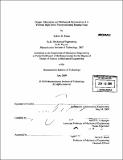| dc.contributor.advisor | Martin L. Culpepper. | en_US |
| dc.contributor.author | Panas, Robert M. (Robert Matthew) | en_US |
| dc.contributor.other | Massachusetts Institute of Technology. Dept. of Mechanical Engineering. | en_US |
| dc.date.accessioned | 2010-01-07T20:52:57Z | |
| dc.date.available | 2010-01-07T20:52:57Z | |
| dc.date.copyright | 2009 | en_US |
| dc.date.issued | 2009 | en_US |
| dc.identifier.uri | http://hdl.handle.net/1721.1/50558 | |
| dc.description | Thesis (S.M.)--Massachusetts Institute of Technology, Dept. of Mechanical Engineering, 2009. | en_US |
| dc.description | Includes bibliographical references (p. 204-206). | en_US |
| dc.description.abstract | The intent of this research is to generate the knowledge required to design, fabricate and operate a device capable of high speed nano-scale vertical positioning of microscopy samples. The high speed focusing device (HSFD) created during this research utilizes a new combination of technologies for the purpose of imaging: Lorentz coil actuation, flexural bearings and strain gage sensing. The application of the technologies combined with precision design principles, as used in the HSFD, result in a demonstrated combination of performance and cost gains over a measured commercially available system. The HSFD is able to perform steps with 8 ms 95% settling time, 2% dynamic accuracy, and 0.005% static accuracy while operating with a resolution of 10.5 nm (l[sigma]) over a range of 500 [mu]m at a cost of about $1400. This performance is 3x faster stepping, 2x better dynamic accuracy, ~~100x better static accuracy, equivalent resolution and range to the top of the line commercial devices at less than half of the cost. The reduced cost is envisioned to enable greater distribution and use of nano-positioning imaging stages, while the increased performance is envisioned to enable faster, more benign (in the case of biological sciences) and more precise imaging. The increased use and data gathering ability of the new device are envisioned to enable fields of research such as biology and materials science to extend their bounds further into the micro/nano-scale as well as further along the time scale for both high speed and low speed processes. | en_US |
| dc.description.statementofresponsibility | by Robert M. Panas. | en_US |
| dc.format.extent | 217 p. | en_US |
| dc.language.iso | eng | en_US |
| dc.publisher | Massachusetts Institute of Technology | en_US |
| dc.rights | M.I.T. theses are protected by
copyright. They may be viewed from this source for any purpose, but
reproduction or distribution in any format is prohibited without written
permission. See provided URL for inquiries about permission. | en_US |
| dc.rights.uri | http://dspace.mit.edu/handle/1721.1/7582 | en_US |
| dc.subject | Mechanical Engineering. | en_US |
| dc.title | Design, fabrication and mechanical optimization of a flexural high speed nanopositioning imaging stage | en_US |
| dc.type | Thesis | en_US |
| dc.description.degree | S.M. | en_US |
| dc.contributor.department | Massachusetts Institute of Technology. Department of Mechanical Engineering | |
| dc.identifier.oclc | 463628833 | en_US |
